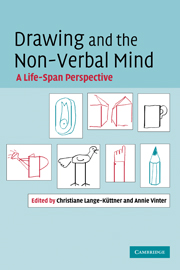Book contents
- Frontmatter
- Contents
- Contributors
- 1 Contemporary enquiries into a long-standing domain: Drawing research
- Part I Self, symbols and intention
- 2 Understanding reflections of self and other objects
- 3 Drawing production, drawing re-experience and drawing re-cognition
- 4 Style and other factors affecting children's recognition of their own drawings
- 5 Children's understanding of the dual nature of pictures
- 6 Pictorial intention, action and interpretation
- Part 2 Syntax, space systems and projection
- Part III Aging, blindness and autism
- Index
- References
5 - Children's understanding of the dual nature of pictures
Published online by Cambridge University Press: 22 September 2009
- Frontmatter
- Contents
- Contributors
- 1 Contemporary enquiries into a long-standing domain: Drawing research
- Part I Self, symbols and intention
- 2 Understanding reflections of self and other objects
- 3 Drawing production, drawing re-experience and drawing re-cognition
- 4 Style and other factors affecting children's recognition of their own drawings
- 5 Children's understanding of the dual nature of pictures
- 6 Pictorial intention, action and interpretation
- Part 2 Syntax, space systems and projection
- Part III Aging, blindness and autism
- Index
- References
Summary
Jolley explains that humans have invented symbols to extend the means by which we can communicate with each other, and pictures are a symbol system that plays an important role in that communication. In order to participate in our society, therefore, it is crucial to understand the conceptual nature of symbols, including pictures. In essence, this means to understand their dual nature: that they are objects in themselves and representations of some other reality. This chapter introduces four facets that contribute to a fully mature understanding of the dual nature of pictures, and discusses the literature on babies, infants and children that relates to their understandings of each of these facets. The chapter concludes by collating this evidence to describe a developmental path by which children come to understand the conceptual basis of pictures.
Our symbolic world
humans' invention of symbols is one of our most important achievements. It allows a degree of communication and understanding not present in animals. The range and pervasiveness of symbols in the world are so endemic to our species that it is easy to forget how much we depend upon them, or that they are symbols at all. We are so experienced with symbols that, on most occasions, we read the meaning of the symbol directly without first having to decode it from the arbitrary and meaningless properties of the symbol (e.g. the squiggly marks that form written language).
- Type
- Chapter
- Information
- Drawing and the Non-Verbal MindA Life-Span Perspective, pp. 86 - 103Publisher: Cambridge University PressPrint publication year: 2008
References
- 3
- Cited by



